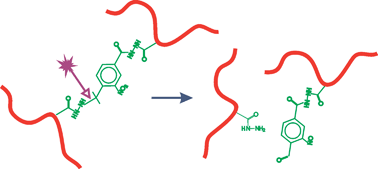A photo-modulatable material for probing cellular responses to substrate rigidity†
Abstract
Recent studies indicate that extracellular mechanical properties, including rigidity, profoundly affect cellular morphology, growth, migration, and differentiation [R. J. Pelham, Jr. and Y. Wang, Proc. Natl. Acad. Sci. U. S. A., 1997, 94(25), 13661–13665; H. B. Wang, M. Dembo and Y. L. Wang, Am. J. Physiol. Cell Physiol., 2000, 279(5), C1345–C1350; P. C. Georges, and P. A. Janmey, J. Appl. Physiol., 2005, 98(4), 1547–1553; C. M. Lo, H. B. Wang, M. Dembo and Y. L. Wang, Biophys. J., 2000. 79(1), 144–152; D. E. Discher, P. Janmey and Y. L. Wang, Science, 2005, 310(5751), 1139–1143; A. J. Engler, M. A. Griffin, S. Sen, C. G. Bonnemann, H. L. Sweeney and D. E. Discher, J. Cell Biol., 2004, 166(6), 877–887]. However, most studies involving rigidity sensing have been performed by comparing cells on separate substrata of fixed stiffness. To allow spatial and/or temporal manipulation of mechanical properties, we have developed a modulatable hydrogel by reacting linear polyacrylamide (PA) with a photosensitive crosslinker. This material allows UV-mediated control of rigidity, softening by 20–30% upon irradiation at a dose tolerated by live cells. Global UV irradiation induces an immediate recoiling of 3T3 fibroblasts and a reduced spread area at steady state. Furthermore, localized softening of the posterior substratum of polarized cells causes no apparent effect, while softening of the anterior substratum elicits pronounced retraction, indicating that rigidity sensing is localized to the frontal region. This type of material allows precise spatial and temporal control of mechanical signals for both basic research and regenerative medicine.


 Please wait while we load your content...
Please wait while we load your content...